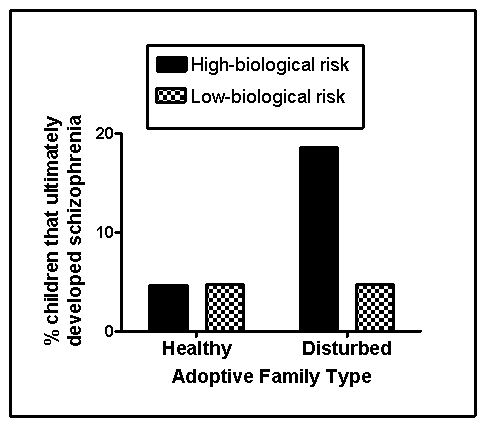Use the following to answer questions
Scenario II
The following scenario presents fabricated data consistent with the results of the following study:
Tienari,P. ,Wynne,L.C. ,Sorri,A. ,Lahti,I. ,Läksy,K. ,Moring,J. ,& ...Wahlberg,K.(2004) .Genotype-environment interaction in schizophrenia-spectrum disorder: Long-term follow-up study of Finnish adoptees.The British Journal of Psychiatry,184(3) ,216-222.doi:10.1192/bjp.184.3.216
Schizophrenia affects approximately 1% of the general population and is characterized by the profound disruption of basic psychological processes;a distorted perception of reality;altered or blunted emotional affect;and disturbances in thought,motivation,and behavior.The symptoms of schizophrenia are varied and are typically classified as either positive or negative.Positive symptoms of schizophrenia refer to thoughts and behaviors typically not observed in those without the disease and can include things like delusions (patently false beliefs) ,hallucinations (false perceptual experiences) ,and disorganized speech.Negative symptoms of schizophrenia are deficits or disruptions in normal behaviors,such as social withdrawal.Cognitive deficits in executive functioning,attention span,and working memory may also be observed.
The symptoms of schizophrenia usually begin in late adolescence and the disease has a strong genetic component.Over the years,a number of biological factors have been linked to schizophrenia,although none alone adequately accounts for the disorder.One such example is the dopamine hypothesis,which states that schizophrenia is related to an excess in dopamine activity.Another theory points to enlarged brain ventricles and progressive cortex tissue loss as predictive of schizophrenia.Although only a minority of persons with schizophrenia have enlarged ventricles,this structural anomaly can appear in those without the disease,and dopamine antagonists may also produce this effect.
Although research into the environmental determinants of schizophrenia has focused largely on the prenatal environment,psychological and social factors also contribute.Tienari and colleagues (2004) compared the risk of developing schizophrenia in children adopted into healthy versus disturbed families,the latter characterized by extreme conflict,volatile relationships,and communication deficits.Some of these children under investigation were identified as at-risk genetically for schizophrenia because their biological mothers were schizophrenic.The remainder were classified at low risk.The investigators utilized a longitudinal design and obtained the diagnostic status of the children with respect to schizophrenia when they reached young adulthood.Fabricated results consistent with this study are shown in Figure 15.2
Figure 15.2 
-(Scenario II) The fabricated results consistent with those obtained by Tienari and colleagues (2004) and shown in Figure 15.2 suggest that:
Definitions:
Unconditional Positive Regard
A concept in psychology that refers to accepting and supporting a person regardless of what they say or do, especially in a therapist-client relationship.
Operant Conditioning
An approach to behavior modification that relies on the leveraging of rewards or the infliction of punishments to adjust behavior levels.
Token Economy
A behavior modification system that utilizes tokens as a form of currency for positive behaviors, which can later be exchanged for desired rewards or privileges.
Systematic Desensitization
A type of behavioral therapy used to gradually reduce phobic reactions and anxiety through counterconditioning.
Q16: Which domain is NOT part of the
Q20: The main cause of coronary heart disease
Q26: Most therapists who work with anxiety and
Q48: Today,electroconvulsive therapy (ECT)is primarily used to treat
Q60: Which function is NOT one associated with
Q81: Audrey is suffering from depression that was
Q97: _ stress _ the aging process.<br>A)Acute;temporarily halts<br>B)Acute;accelerates<br>C)Chronic;temporally
Q125: Lymphocytes are _ blood cells that _
Q197: A manic episode must last at least
Q202: Over the course of their lives,approximately what